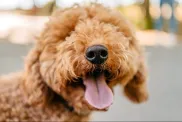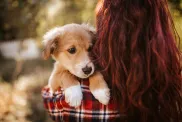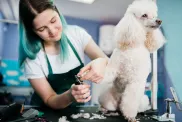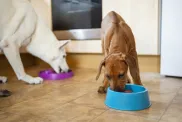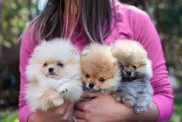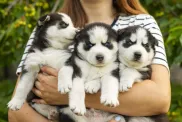The Huskydoodle, also called the Huskypoo, is a medium-sized crossbreed between the Siberian Husky and the Poodle. This hybrid breed goes by several other names, including the Husky Poodle, Siberpoo, Poosky, and Siberian Poodle. This beloved breed inherits the Husky’s distinctive coat markings and the Poodle’s hypoallergenic qualities. To that end, these dogs can be appealing for individuals with allergen sensitivities. Known for their social and outgoing demeanor, the Husky Poodle mix thrives on companionship and makes an excellent family pet. Their intelligence and agility make them well-suited for various activities, including obedience training and agility courses. However, potential owners should be prepared for their energetic nature and commit to providing regular exercise and mental stimulation.
In terms of grooming, the Huskydoodle’s coat requires regular care to prevent matting and tangling. While they may not shed as much as the Siberian Husky, the Poodle-ancestry means the coat can be prone to matting if left unattended. The breed’s loyalty and friendly disposition contribute to their suitability as both a devoted family companion and a playful partner for individuals or active households. As with any hybrid breed, prospective owners should consider both parent breeds’ specific needs and characteristics to ensure a harmonious match with their lifestyle and preferences.
Huskydoodle characteristics
- Height: 12 to 25 inches at the shoulder
- Weight: 40 to 60 pounds
- Lifespan: 10 to 14 years
coat and color variations
The coat and color of a Huskydoodle can vary significantly, depending on which parent breed they take after more.
Coat types:
- Curly and dense: If the Poodle’s genes are dominant, the coat may be curly, dense, and hypoallergenic. This type of coat tends to shed less.
- Straight or wavy: If the Husky’s genes are stronger, the coat might be straight or wavy, resembling the Husky’s double coat. This type tends to shed more and may require more grooming.
- Combination: Some Huskydoodles have a combination of both wavy and curly patches, resulting in a unique coat texture.
Huskydoodles come in a wide range of color variations, influenced by both the Poodle and Husky parent breeds. They can have solid-colored coats in shades like white, black, brown, or gray, with white being more common in those with stronger Poodle genetics. Many Huskydoodles also inherit the Husky’s signature multi-colored patterns, combining black, white, gray, and brown in striking combinations. Some may even have a more mixed or marbled appearance, giving them a unique, eye-catching look. The diverse color variations of Huskydoodles make each one quite distinct, with no two looking exactly alike.
Physical appearance and traits
- Ears: Their ears can stand erect like a Husky’s, or they may be floppier like the Poodle’s.
- Body Shape: The body of a Huskydoodle is typically medium-sized with a strong, athletic build, showing the lean musculature of the Husky and the elegance of the Poodle.
- Head: Their head can vary between the more wolf-like appearance of the Husky, with a broader face and erect ears, or have a slightly narrower skull like a Poodle. The snout can range from long and slender to more medium-sized.
- Eyes: Huskydoodles may inherit the striking blue eyes of the Husky, although brown or even heterochromatic eyes (one blue, one brown) are also possible.
- Tail: A bushy, curled tail resembling the Husky’s tail is common, but some may have the Poodle’s less curled tail.
How big does the Huskydoodle get?
The size of a Huskydoodle depends on the size of the Poodle parent, as Poodles come in standard, miniature, and toy sizes. However, most Huskydoodles are bred from standard Poodles and Siberian Huskies, making them medium to large-sized dogs.
- Height: Typically between 13 and 25 inches (33-63 cm) at the shoulder.
- Weight: The weight can range from 40 to 60 pounds (18-27 kg), but some may be smaller or larger depending on the size of the Poodle parent.
Larger Huskydoodles (from a standard Poodle and Husky) tend to be closer to the 50-60 pound range, while smaller ones (if bred from a mini Poodle) may weigh closer to 30-40 pounds.
Huskydoodle history
Like many hybrid dogs, the Huskydoodle’s origins are unclear, but the breed likely became popular in the early 21st century when designer dog breeds gained widespread attention for combining the desirable traits of two purebred dogs. The goal behind breeding Huskydoodles was to create a dog that blends the intelligence, low-shedding coat, and hypoallergenic qualities of the Poodle with the Husky’s athleticism, endurance, and striking appearance. While still not as established as their parent breeds, the Huskydoodle continues to grow in popularity due to their versatility, affectionate nature, and family-friendly traits.
Huskydoodle personality
The Huskydoodle is an energetic, intelligent, and affectionate hybrid breed. Known for their playful and friendly nature, they thrive in social environments and are great with families, children, and other pets. Highly trainable due to their intelligence, Huskydoodles are quick learners but may display a streak of independence or mischief, particularly from the Husky side. They require plenty of physical activity and mental stimulation to stay happy and avoid boredom. With their loyal and loving temperament, Huskydoodles make devoted companions, though they don’t enjoy being left alone for long periods.
Temperament and traits:
- Intelligent and Trainable: Both parent breeds are intelligent, so Huskydoodles are highly trainable and quick to learn.
- Energetic: This is a high-energy dog, especially if it takes after the Husky parent. They require ample exercise and mental stimulation.
- Friendly and Social: Huskydoodles are friendly and often great with people, children, and other pets. They enjoy companionship and may not like being left alone for long periods.
- Playful and Mischievous: Huskydoodles may have a playful, even mischievous personality, inherited from the Husky side.
- Affectionate: While they love playtime, they can also be affectionate and love bonding with their human families.
Training and socialization
Early socialization and positive reinforcement training are crucial due to their intelligence and potential stubbornness. Of course, their intelligence allows them to pick up commands quickly, so early training is key to establishing good behavior from the start. Use praise, treats, and affection to reward desired behavior. Huskydoodles respond well to positive reinforcement, and this approach will keep them motivated and engaged.
Training tips:
- Be Consistent: Consistency is crucial in training. Use the same commands and routines to avoid confusion. This helps your Huskydoodle understand what is expected of them.
- Keep Training Sessions Short and Fun: Huskydoodles are intelligent but can lose interest if training sessions are too long or repetitive. Keep sessions short (10-15 minutes) and engage with varied activities.
- Mental Stimulation: Incorporate puzzle toys, obedience training, and interactive games into their routine to challenge their mind. A bored Huskydoodle can become restless or destructive. Once basic obedience is established, teach more advanced commands or tricks. Their intelligence makes them excellent candidates for agility training, fetch, or scent games.
How long can a Huskydoodle be left alone?
Huskydoodles are very active and highly social. They generally do not do well when left alone for long periods. They thrive on companionship and interaction, both because of their affectionate nature and their intelligence. Ideally, a Huskydoodle should not be left alone for more than 4 to 6 hours at a time.
Huskydoodle care
As with all dogs, it’s important to keep up your Huskydoodle’s regular veterinary checkups to detect any health concerns early. Your vet can help you develop a care routine that will keep your dog healthy.
How much exercise does a Huskydoodle need?
A couple of walks every day, totaling around 45 to 60 minutes, should do the trick to keep your Huskydoodle happy and healthy. Some may need more intense exercise, especially if they take after their Husky parent. Remember, Siberian Huskies were born to run! Furthermore, due to their remarkable intelligence, it’s of great benefit to incorporate obedience tasks into the exercise mix to keep them interested and mentally stimulated.
Huskydoodle grooming needs
Huskydoodles have diverse grooming needs due to the variability in their coats, which can range from curly and low-shedding like a Poodle to straight and dense like a Husky. Regular grooming is essential to maintain their coat’s health and appearance, as well as to prevent tangles, matting, and excess shedding. Huskydoodles with curly coats may need more frequent grooming sessions, while those with straighter Husky-like coats shed more, especially during seasonal changes. Regardless of coat type, consistent care, including brushing, bathing, and trimming, is key to keeping a Huskydoodle’s coat clean, manageable, and healthy.
How to groom a Huskydoodle
Brushing:
- Frequency: Brush your Huskydoodle 2-3 times a week for curly coats or daily for straighter, shedding coats.
- Tools: Use a slicker brush or de-shedding tool for straighter coats, and a pin brush or comb for curly or wavy coats.
- Technique: Work in sections, brushing from the skin outward to remove tangles, prevent matting, and manage shedding. For curly coats, pay special attention to high-friction areas (around the ears, under the legs) where matting occurs most.
Bathing:
- Frequency: Bathe your Huskydoodle every 4-6 weeks or as needed, depending on activity level and coat type. Use a mild, dog-friendly shampoo that suits their skin and coat type. Consider a moisturizing or hypoallergenic shampoo for sensitive skin.
- Drying: After bathing, towel dry and use a blow dryer on a low heat setting to prevent dampness, which can lead to skin issues in dense or curly coats.
Hair trimming:
- Frequency: If your Huskydoodle has a curly Poodle-like coat, professional trimming may be needed every 6-8 weeks to maintain a manageable length and neat appearance.
- Style: Some owners prefer a “teddy bear” trim, which gives a rounded, fluffy look, while others opt for a more natural, slightly longer coat.
- Face and paws: Keep the hair around the face, ears, and paws trimmed to prevent irritation and maintain a tidy look.
Ear cleaning:
- Frequency: Clean the ears once a week to avoid infections, especially for Huskydoodles with floppy ears. Use a vet-approved ear cleaner and a cotton ball or pad to gently wipe the outer ear. Avoid inserting anything deep into the ear canal.
Nail trimming:
- Frequency: Trim your Huskydoodle’s nails every 3-4 weeks, or when you hear them clicking on the floor.
- Tools: Use a nail clipper or grinder designed for dogs, being careful not to cut into the quick (the sensitive part of the nail).
Teeth brushing:
- Frequency: Brush your dog’s teeth 2-3 times a week to maintain oral health. Use a dog-specific toothbrush and toothpaste to prevent tartar buildup and ensure healthy gums.
Flea, tick, and parasite control
Keep up with flea and tick prevention treatments, especially if your Huskydoodle spends much time outdoors. Regular grooming allows you to spot parasites early.
Early acclimation is key
Getting your Huskydoodle accustomed to grooming procedures from a young age makes the process easier and more enjoyable for both of you. Handle their paws frequently, examine their mouth and ears, and reward them for good behavior during grooming sessions. This positive foundation sets the stage for stress-free veterinary exams and handling throughout their lives.
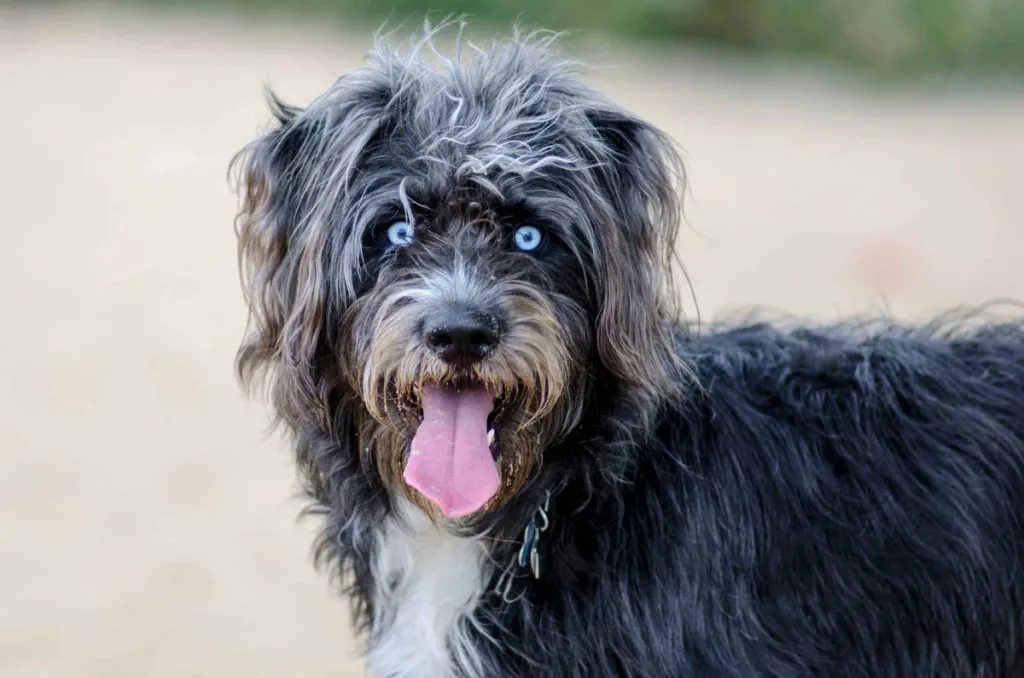
Feeding and nutrition
An ideal Huskydoodle diet should be formulated for a medium breed with medium energy. Husky Poodle mixes need to stick to a healthy diet, as overeating can cause weight gain and associated health problems, especially if adequate exercise isn’t offered.
As with all dogs, the Huskydoodle’s dietary needs will change from puppyhood to adulthood and will continue to change into their senior years. You should ask your veterinarian for recommendations about your Huskydoodle’s diet, as there is far too much variation among individual dogs–including weight, energy, and health–to make a specific recommendation.
- Adult Portions: Feed an adult Huskydoodle based on their weight, size, and activity level. On average, a medium-sized adult (30-50 lbs) Huskydoodle will need about 2-3 cups of dry food per day. A larger dog (50-60 lbs or more) may need 3-4 cups per day.
- Adjust According to Activity Level: Highly active Huskydoodles, especially those engaged in agility training or long runs, may need more food than less active ones. Always monitor their weight and adjust portions accordingly.
Huskydoodle family compatibility
Huskydoodles are highly compatible with families, making them excellent family pets due to their affectionate, playful, and social nature. They are known to be friendly and patient with children, often enjoying active play and bonding with family members. Their intelligence and trainability allow them to fit well into a family routine, though they do need plenty of exercise and mental stimulation to stay happy, especially in households with an active lifestyle. Huskydoodles also tend to get along well with other pets if properly socialized. Their loyal, loving temperament means they form strong bonds with their family.
Is the Huskydoodle good with children?
Yes, the Husky Poodle mix is generally very good with children. Their playful, energetic, and friendly nature makes them great companions for kids, especially in active households. Huskydoodles are typically affectionate and patient, often enjoying playtime and outdoor activities, which helps them bond well with children. Their intelligence also makes them quick learners, so they can be easily trained to behave appropriately around young ones. However, due to their high energy levels, it’s important to supervise interactions with very young children to ensure that their excitement doesn’t lead to unintentional rough play.
Huskydoodle health issues
The Huskydoodle mixed breed is predisposed to some of the same conditions the Poodle and the Siberian Husky also face. While most are generally healthy, some may be prone to a few health issues, which is why it is important to maintain good care and keep up with regular veterinary appointments. Some of the more common health problems Huskydoodles suffer from include:
- Hip Dysplasia: Hip dysplasia is a genetic condition where the hip joint doesn’t develop properly, leading to instability and wear and tear. This can result in arthritis and pain, impacting a dog’s mobility over time.
- Elbow Dysplasia: Elbow dysplasia is a developmental disorder affecting the elbow joint. It involves abnormal growth and formation, leading to joint incongruity. Elbow dysplasia can cause pain, lameness, and arthritis in affected dogs.
- Allergies: Allergies in dogs can manifest as reactions to environmental factors (such as pollen or dust), food, or substances they come into contact with. Symptoms may include skin irritation, itching, digestive issues, or respiratory problems.
- Skin Issues: Skin issues in dogs encompass a range of conditions, including infections, allergies, or dermatitis. Common symptoms include itching, redness, dryness, or the presence of rashes. Identifying the underlying cause is crucial for effective treatment.
- Bloat: Bloat, or gastric dilatation-volvulus (GDV), is a serious and potentially life-threatening condition where a dog’s stomach fills with gas and twists on itself. This emergency requires immediate veterinary attention, as it can lead to rapid and severe consequences, including organ damage and shock.
Huskydoodle rescue groups
It may be hard to find a breed-specific rescue for Huskydoodles because they are a mixed breed. However, you may want to try Siberian Husky or Poodle breed-specific rescues, as they often care for mixes, as well. Here are some rescues you can try:
Should you decide to purchase a Huskydoodle puppy, finding a reputable dog breeder is incredibly important. Reputable breeders are committed to breeding healthy, well-socialized puppies that will make great companions. They will screen their breeding stock for health problems, socialize their puppies from a young age, and provide you with lifetime support.
On the other hand, backyard breeders are more interested in making a profit than in producing healthy, well-adjusted dogs. They may not screen their breeding stock for health problems, and they may not socialize their puppies properly. As a result, puppies from backyard breeders are more likely to have both health and behavioral issues.
How much is a Huskydoodle puppy?
The price of a Huskydoodle puppy can vary depending on factors such as the breeder, the puppy’s lineage, coat type, and location. On average, a Huskydoodle puppy from a reputable breeder costs between $1500 and $2,500. Puppies from well-established breeders, those with unique coat colors or hypoallergenic qualities, or those with parents from champion bloodlines may be priced on the higher end. Additionally, factors like demand in certain regions and the breeder’s reputation can affect the cost. When purchasing a Huskydoodle, it’s important to choose a reputable breeder who prioritizes health testing and proper care over simply profit.
